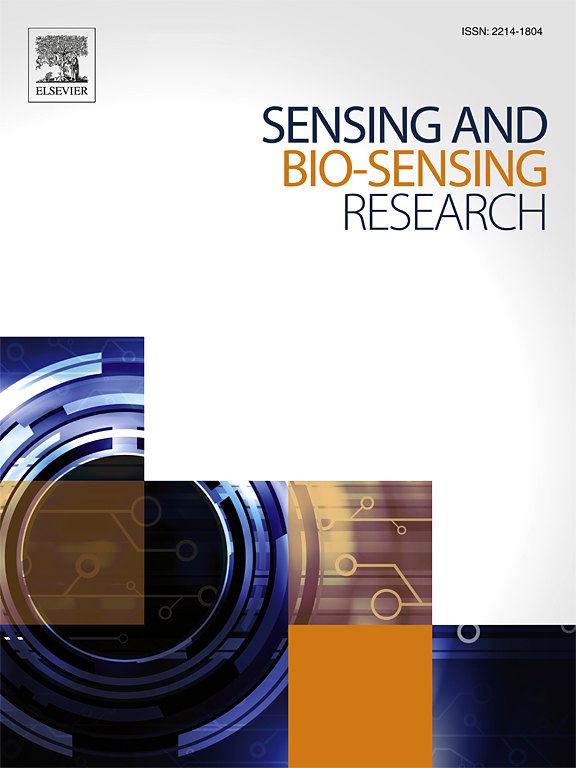用茜素红s修饰玻碳电极测定药物和血清中扑热息痛的绿色伏安策略
IF 4.9
Q1 CHEMISTRY, ANALYTICAL
引用次数: 0
摘要
本研究利用茜素红S(聚(ARS)/GCE)修饰的玻碳电极,建立了一种高灵敏度的电化学检测药物片剂和人血清样品中扑热息痛(PCT)的方法。PCT是应用最广泛的镇痛解热药物之一;然而,过量或长期使用会导致严重的肝脏和肾脏损伤。因此,开发敏感可靠的方法来监测药物制剂和生物液体中的PCT水平对于确保药物安全和有效的治疗监测至关重要。电极的表征证实,导电和电活性聚合物膜(聚(ARS))的表面改性显著提高了电极的有效表面积,降低了电荷转移电阻。与未修饰的电极相比,修饰后的电极在明显较低的电位下呈现出一个清晰的、不可逆的氧化还原峰,电流增加了6倍,突出了改性剂对PCT的催化效率。通过循环伏安法和方波伏安法分析了PCT的电化学行为,发现导电聚合物涂层显著增强了PCT的灵敏度和选择性。在优化的电极条件下,poly(ARS)/GCE的方波伏安电流响应在0.01 ~ 250.0 μM范围内呈线性关系,在pH 7.0的磷酸盐缓冲溶液中具有1.0 nM的超低检出限。在实际样品上的分析应用证实了该方法的准确性,即使存在潜在的干扰,该方法对片剂和人血清的回收率也达到98.8 - 100.3%。与之前报道的电化学方法相比,所开发的方法提供了一种具有成本效益和稳健的PCT定量替代方法。本文章由计算机程序翻译,如有差异,请以英文原文为准。
Green voltammetric strategy for sensitive determination of paracetamol in pharmaceuticals and serum using alizarin red S-modified glassy carbon electrodes
This study introduces a highly sensitive electrochemical method for detecting paracetamol (PCT) in pharmaceutical tablets and human serum samples, utilizing a glassy carbon electrode modified with alizarin red S (poly (ARS)/GCE). PCT is one of the most widely used analgesic and antipyretic drugs; however, its overdose or prolonged use can lead to severe liver and kidney damage. Therefore, the development of sensitive and reliable methods for monitoring PCT levels in pharmaceutical formulations and biological fluids is crucial for ensuring drug safety and effective therapeutic monitoring. Characterization of the electrode confirmed that the surface modification with a conductive and electroactive polymer film (poly(ARS)) significantly enhanced the effective electrode surface area and reduced charge transfer resistance. Compared to the unmodified electrode, the modified electrode exhibited a well-resolved, irreversible redox peak at a significantly lower potential with a sixfold increase in current, highlighting the catalytic efficiency of the modifier toward PCT. The electrochemical behavior of PCT was analyzed via cyclic voltammetry and square wave voltammetry, revealing significantly enhanced sensitivity and selectivity due to the conductive polymer coating. Under optimized electrode condition square wave voltammetric current response of poly(ARS)/GCE showed linear dependence on concentration of 0.01–250.0 μM and an ultralow detection limit of 1.0 nM in phosphate buffer solution (pH 7.0). Analytical application on real samples confirmed the method's accuracy, achieving recovery rates of 98.8–100.3 % for pharmaceutical tablets and human blood serum, even in the presence of potential interferents. The developed method provides a cost-effective and robust alternative for PCT quantification, with superior performance compared to previously report electrochemical approaches.
求助全文
通过发布文献求助,成功后即可免费获取论文全文。
去求助
来源期刊

Sensing and Bio-Sensing Research
Engineering-Electrical and Electronic Engineering
CiteScore
10.70
自引率
3.80%
发文量
68
审稿时长
87 days
期刊介绍:
Sensing and Bio-Sensing Research is an open access journal dedicated to the research, design, development, and application of bio-sensing and sensing technologies. The editors will accept research papers, reviews, field trials, and validation studies that are of significant relevance. These submissions should describe new concepts, enhance understanding of the field, or offer insights into the practical application, manufacturing, and commercialization of bio-sensing and sensing technologies.
The journal covers a wide range of topics, including sensing principles and mechanisms, new materials development for transducers and recognition components, fabrication technology, and various types of sensors such as optical, electrochemical, mass-sensitive, gas, biosensors, and more. It also includes environmental, process control, and biomedical applications, signal processing, chemometrics, optoelectronic, mechanical, thermal, and magnetic sensors, as well as interface electronics. Additionally, it covers sensor systems and applications, µTAS (Micro Total Analysis Systems), development of solid-state devices for transducing physical signals, and analytical devices incorporating biological materials.
 求助内容:
求助内容: 应助结果提醒方式:
应助结果提醒方式:


